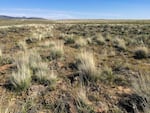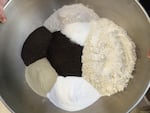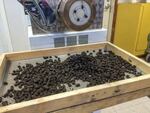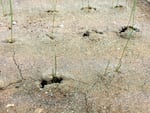Producer: Vince Patton, Videographer: Todd Sonflieth, Editor: Lisa Suinn-Kallem
Additional Photos & Video: George Orr - Bureau of Land Management and The Nature Conservancy
Immense tracts of sagebrush desert can be deceiving.
Eastern Oregon is part of the largest natural grassland in North America stretching across seven western states.

Oregon's sagebrush steppe.
Vince Patton / Oregon Public Broadcasting
However, there’s a problem.
A lot of the grass doesn’t belong.
Jay Kerby, a range land ecologist with the
says exotic invasives from Asia and Europe hitched a ride in over a hundred years ago.
“They create a lot of problems for us,” Kerby says. “Those exotic annual plants are so well adapted that they basically out compete a lot of our native plants, especially our native plant seedlings.”
Non-native grasses take over; they set up the desert for a vicious cycle.
They burn much more readily than the slow growing native grasses and Oregon has had a number of devastating wildfires in the last few years.
Kerby says, “Fire was a natural part of this ecosystem but annual grasses have totally changed that dynamic to where instead of a fire every 30, 50 or 100 years, we’re seeing fires on the order of 5 to 10 years.”
Sage grouse rely on the sagebrush and grasses. Ranchers need grass they can count on for their cattle.
After fires, the government has come in to reseed. Crews try to give the desert a boost to come back.
“T\the more of these large bunch grasses we have,” says Kerby, “the less vulnerable we are to those exotic annual grasses invading.”
Since 2010, just in Oregon, the Bureau of Land Management has reseeded nearly a quarter million acres.
They spent than $51 million to do it.
The sad truth is, reseeding the desert usually fails.
“That’s what people don’t want to talk about,” says Tony Svejcar, head of the USDA’s Agricultural Research Center in Burns.
“We have relatively poor success rates re-seeding rangeland, particularly arid rangeland and particularly with natives.”
He says when the desert gets replanted with more of those introduced species maybe 50 percent will survive.
But try putting in the native seeds that they really want, and 90 to 95 percent die in the desert crust.
Svejcar says, “It’s more complicated than ‘It’s a dry year.’ All our years are dry years. We’ve got to get creative because what we’ve been doing hasn’t been working for decades really.”
His team is trying to shake things up with a brand new recipe - of pasta.
“We’re kind of recreating pastas if you will,” says USDA ecologist Matt Madsen. “We went from spaghetti and linguine to now, sagebrush pellets.”
In Burns, the researchers don’t just watch grass grow; they’re
to make sure seeds grow into thriving, healthy plants.
“We call it the Colonel’s secret recipe, 11 herbs and spices we’ve put together to enhance seedling emergence from the soil,” says Madsen.

Researchers combine a proprietary blend of soils, seeds and super absorbent polymers.
Vince Patton / Oregon Public Broadcasting
He has spent four years on his special seed formula.
Out of a mixer comes fluffy “dough” of soil, seeds and super absorbent polymers to attract and keep moisture near the seeds.
Madsen says, “it’s similar to the polymers they’re putting in baby diapers to absorb water.”
Matt’s mission is to get water to the seeds when they need it.
To do that, he’s reinventing Italian food. Matt’s special seed dough gets mashed through a pasta machine made in Italy.
Out comes sagebrush spaghetti chopped up short into pellets.

An Italian pasta machine cranks out seed pellets instead of spaghetti.
Vince Patton / Oregon Public Broadcasting
Project coordinator Vanessa Schroeder, with the Nature Conservancy, cranks out thousands of pellets for scientific planting tests.
The Nature Conservancy was able to land some large donations to fund this joint research with the USDA.
The Nature Conservancy’s Kerby chuckles as he recalls, “My supervisor got a call from our credit card folks asking whether or not he really wanted to approve my purchase, using my VISA, of a $10,000 pasta machine.”
They’ve also got a doughnut machine.
Instead of blueberry cake or vanilla glaze, Matt, Vanessa and their colleagues churn out a conveyor full of specially formulated little, brown pods.
They call them ‘pillows’ because they swell up when wet. And they’re chock full of grass seeds.

Seed "pillows" are designed to hold seeds close together and attract moisture.
Vince Patton / Oregon Public Broadcasting
The pillows and pellets pack in seeds so close, the hope is the plants can work together to grow and break through the desert crust when one seedling might not be able to.

Seedlings break through crusty soil in a lab similar to that on the open desert range.
Vince Patton / Oregon Public Broadcasting
Says Kerby, “We’ve seen some of these things do just amazing things in the laboratory, which is super exciting. We just can’t wait to get out and test them in the field.”
Which methods work best remain an open question.
Jay Kerby says it’s too early to report results.
But he’s seeing enough progress to give him hope that re-seeding burned deserts might one day be successful.
“We are helping some of these seeds overcome the barriers,” says Kerby. “Reestablishing these more stable, more fire resistant native plant communities is going to save us money in the long term.”
Adds Svejcar, “A lot of us really like this native rangeland and we don’t want to see it turned over to these invasives. We can’t just keep giving up ground. We’ve got to start taking it back.”
Figuring out when and how to plant their pasta seedpods remains a delicate balance.
But one lesson is easy.
Sagebrush spaghetti and bunchgrass tortellini both go best with just one kind of sauce.
“I’d say a nice coating of H2O,” says Kerby. “Water is the best sauce.”
Resources and Information
Website for Restoring Sagebrush Steppe
Website for the Science of Seeds
